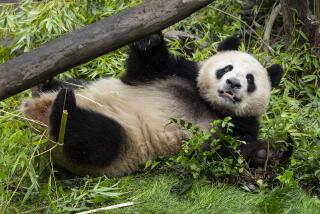A species revived: How the San Diego Zoo helped unlock the mystery of panda sex and parenting
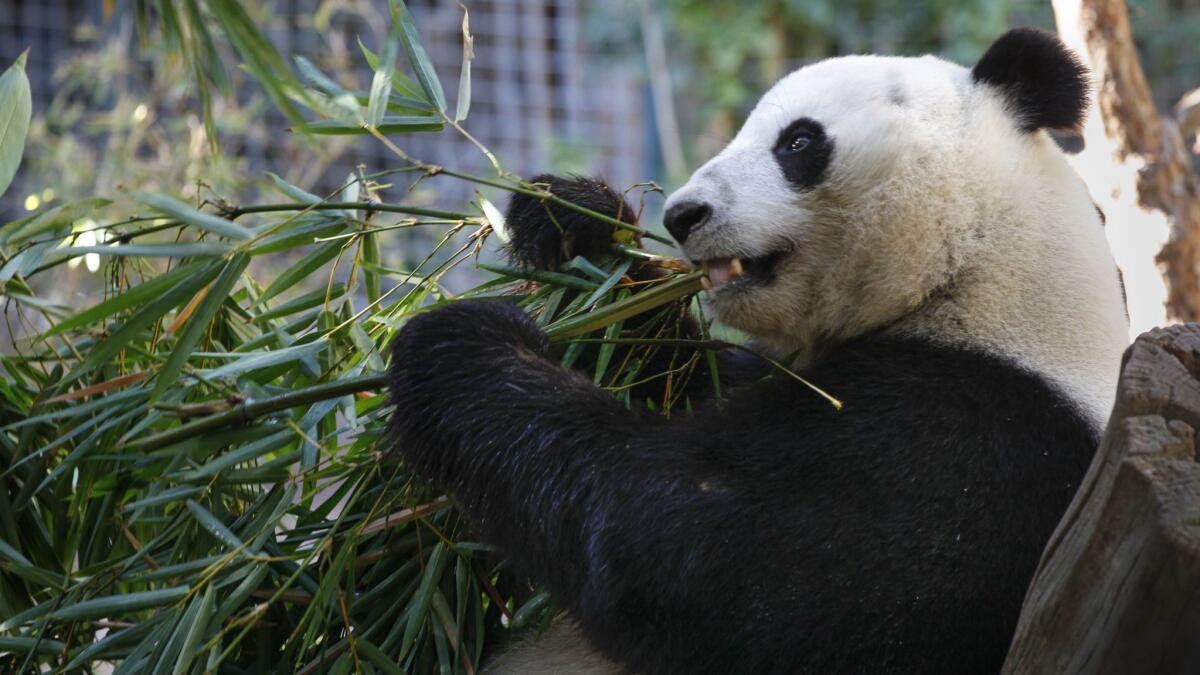
China has extended its loan of giant pandas to the San Diego Zoo until next year. But the goals of the program are changing, thanks to a development almost unthinkable when the conservation project began in 1996.
Partly due to the zoo’s research, breeding programs worldwide have produced a panda population boom. At the San Diego Zoo alone, six panda progeny have emerged from prolific matriarch Bai Yun, 27.
Since pandas no longer face the near-term danger of extinction, talk has shifted to building on the program’s success to bring more long-term stability to the future of these enigmatic bears that are produced by nature but appear to be designed by Disney.
When the program began in 1996, the wild population was estimated at less than 1,000. As of the latest census, in 2014, that population had soared to 1,864, and by some estimates even higher. Reflecting these improved prospects, pandas were upgraded last year from an endangered species to a vulnerable one.
Most importantly, China has devoted considerable attention to protecting native panda habitat in remote mountains of central China where their only food, bamboo, grows.
The wild population is bolstered by more than 300 pandas living in zoos and managed habitats in China and elsewhere. They provide an insurance policy against extinction in the wild, along with giving the zoogoing public an unforgettable symbol of conservation.
Three of these pandas now live at the San Diego Zoo. They are Gao Gao, a 28-year-old wild-born male; Bai Yun, born in the Wolong Giant Panda Research Center; and Xiao Liwu, born at the zoo in 2012 and the last of Bai Yun’s cubs.
Only Bai Yun and Xiao Liwu are on display; the elderly and ailing Gao Gao is being cared for behind the scenes. All pandas lent to the zoo, as well as their offspring, remain the property of China.
But success brought its own challenges, including how to manage a “population explosion” in Chinese breeding centers, said Barbara Durrant, the zoo’s director of reproductive sciences.
Ideally, some of the pandas will be introduced into the wild, bolstering native populations, said Durrant, who has been with the program since its inception.
“That’s the next big push,” she said. “And that’s what we hope for all the species that we work with.”
But captive pandas are used to having people care for all their needs. They can’t just be turned loose — they must be gradually trained in wilderness survival skills. How to do that is still being figured out.
“Pandas that will be potentially released into the wild are born in very large naturalistic enclosures, and have minimal to no human contact prior to release.” said Megan Owen, the zoo’s director of population sustainability “The reintroduction program is certainly a work in progress, but has had reasonably good success to date.”
This dramatic improvement in the panda’s outlook is the product of decades of hard work and cooperation among panda conservationists worldwide, Durrant said.
For its part, the San Diego Zoo has used its access to pandas to probe the mysteries of panda reproduction, including fertility, how pandas choose their mates, and how to improve cub survival. The zoo’s efforts have yielded advances such as making better panda baby formula and even improving the shape of nipples on their feeding bottles.
They have shared that knowledge with panda conservation experts in China and at other zoos in the program in the U.S. and around the world. Likewise, experts at the San Diego Zoo have learned from China and the other zoos, making this truly an international achievement, Durrant said.
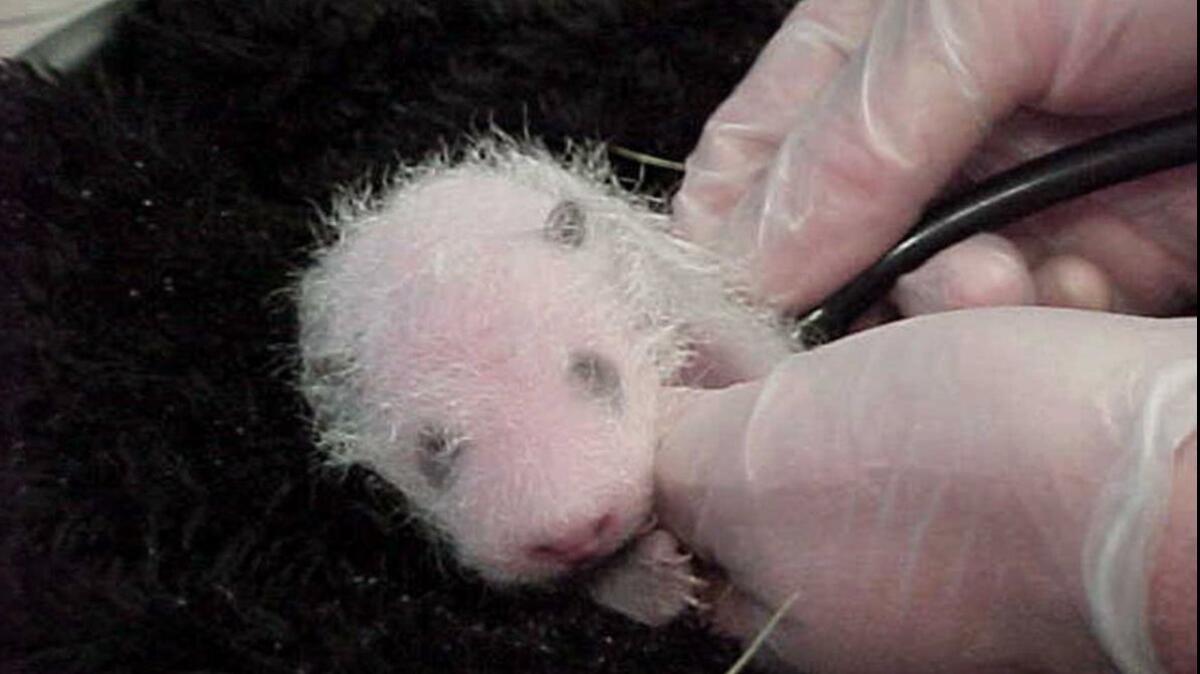
In the mood?
Two pandas were delivered to the zoo under the loan agreement in 1996; Bai Yun and her intended male partner, Shi Shi. A wild-caught panda, Shi Shi was mature, but of indeterminate age.
Giant pandas normally live solitary lives, except when mating and when the mothers raise cubs. Otherwise, their lives revolve around bamboo.
It’s still not entirely clear how these bears, whose close relatives are carnivores, adopted their bamboo-only diet or even how their essentially carnivorous gut digests bamboo. Studies have found that the microbes in the panda’s gut don’t play a significant role in digesting cellulose and lignan, two main components of bamboo.
When they do mate, pandas prepare with an elaborate exchange of signals that get males and females gradually ready.
Scent comes first. Females emit characteristic odors when they are getting ready for estrus, Owen said. This draws males nearby, and they may fight to get access. Their sounds help male and female home in on each other.
Finally, female pandas show by posture that they’re receptive, and the male proceeds with mating.
Knowing this, zoo staff carefully prepared the two for their meeting.
Bai Yun and Shi Shi were housed separately in a specially designed center. They were periodically shifted to each other’s area. This “pen swapping” allows pandas to directly experience the pheromones excreted in their urine and feces, as they would do in nature.
“So when we built this lovely facility, they had a lot of area to see and smell and hear each other, but not introduced to each other, not live together,” Durrant said.
Bai Yun, nearly 5 at the time, was monitored for signs of estrus, and when she was ready, the two were put together.
It was not to be.
Bai Yun demonstrated all the proper signs of receptiveness. However, Shi Shi “was not even remotely interested in Bai Yun,” Owen said.
“He was just interested in eating and sleeping, and was extraordinarily irritated by her continued approaches,” Owen said.
At the time, no one knew why.
Shi Shi, it turned out, probably couldn’t detect Bai Yun’s pheromonal signals, Durrant said. He had been in “a tremendous fight” in the wild before capture. Extensive surgery was required to repair the damage.
“We discovered later through some of the MRIs that were done that his terminal nerve had most likely been severed. And that is the nerve that relays pheromonal information that registers as a sexual communication,” she said.
Reluctantly, the zoo decided to help Mother Nature along. In 1999, zoo staff collected Shi Shi’s semen and artificially inseminated Bai Yun. To their surprise, it worked. Later that year, Bai Yun delivered a healthy female cub, Hua Mei,
This was a milestone, and Hua Mei became the first giant panda born in the United States to survive and grow up. Bai Yun turned out to be a nearly flawless mother to Hua Mei and her five other offspring, Owen said.
But the zoo still had a problem. Its research project — the one that qualified it to receive the pandas in the first place — was to study chemical communication in pandas. So the zoo asked China to exchange Shi Shi for a more suitable panda.
The Chinese agreed. Ronald Swaisgood, head of the zoo’s recovery ecology program, went to China to find a replacement panda. Swaisgood had studied pandas in their native habitat.
“He found that, in a nutshell, that females were more responsive to the scent marks of males, the higher those scent marks were [off the ground], like on a tree,” Durrant said.
Presumably, bigger pandas can place scent marks higher, and females prefer larger pandas, she said.
Swaisgood settled on a smaller but clever male acceptable to the Chinese, Gao Gao. He would mark his scent by doing a handstand, elevating himself higher than normal, and mark vertical surfaces.
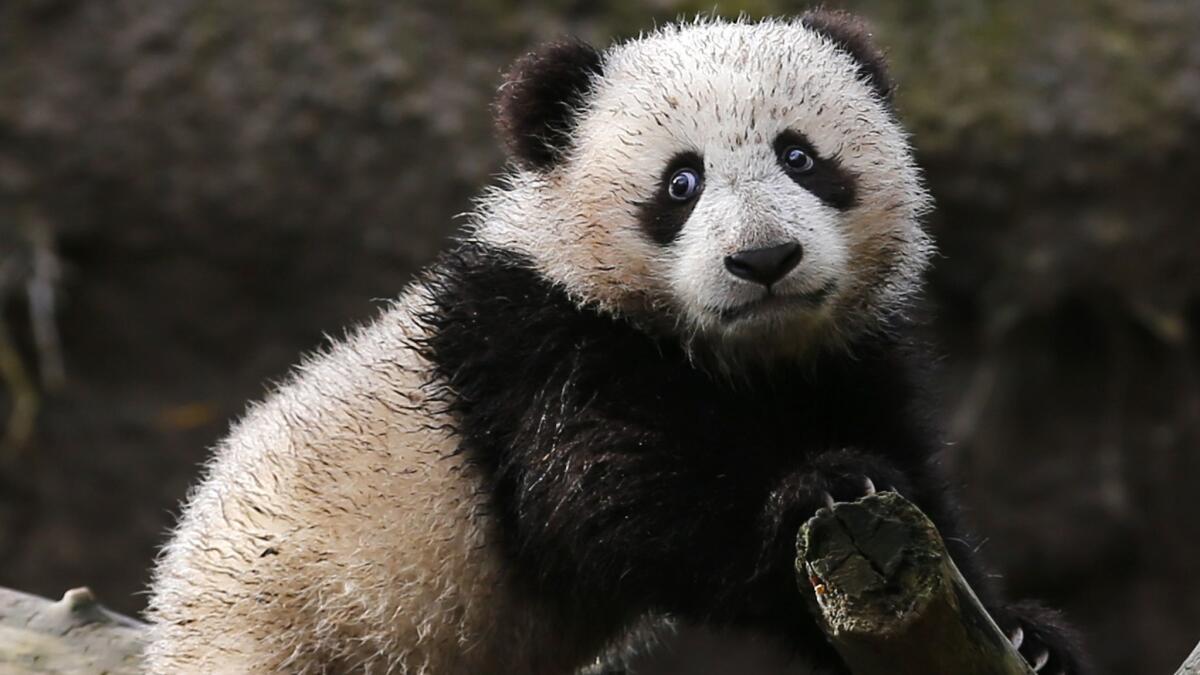
“In fact, he’s smaller than our female, but he showed Ron that he had what it took,” Durrant said. “He was a macho male and Ron was absolutely right.”
This time, the careful dance of introduction was successful. Bai Yun came into estrus early, presumably because the smell of a new male panda stimulated her.
Consummating the courtship, however, proved unexpectedly difficult for Gao Gao.
“Because he’s so much smaller than Bai Yun, he was having a hard time orienting for proper mating,” Durrant said.
“She was very patient with him as she did everything she could to help him orient. Finally, she understood or sensed that she needed to be smaller. And so she lowered herself on the ground and he was able to breed her.”
Not wishing to press their luck, because pandas can be aggressive toward each other, zoo staff then separated them. And just to ensure there was a pregnancy, they again artificially inseminated her, with Shi Shi’s sperm. If a baby resulted, they could test to determine paternity.
A son, Mei Sheng, was born in 2003. Gao Gao was his father. Four other cubs followed: Su Lin in 2005, Zhen Zhen in 2007, Yun Zi in 2009 and the last, Xiao Liwu, in 2012.
The zoo had helped crack the code for panda reproduction.
Learning from each other
The zoo’s success was achieved in partnership with China and other zoos in different countries, Owen said. They shared tips and insights, and helped each other solve problems.
How do you tell if a panda is pregnant? Pandas don’t “show,” because the cub is so tiny compared to the mother, Owen said. Monitoring hormones also didn’t work.
So Bai Yun’s keepers trained her to accept direct examination, by ultrasound and thermal imaging. Surprisingly, Bai Yun regularly became pregnant with twins, but each time one of the embryos was resorbed before birth, Owen said.
With the positive reinforcement of treats and attention, Bai Yun was coaxed by stages into lying down in a crate, and even accepting having some of her fur shaved off to perform thermal imaging.
The bond of trust between keeper and animal makes this all possible, said Durrant, describing how it works.
“Bai Yun is reclining comfortably in her little crate and she’s getting all her favorite treats at the other end,” Durrant said. “And the keepers are talking to her and keeping the treats coming. And they keep her attention focused, and she knows that she’s not going to be hurt. She feels safe. She’s not frightened. And so we can get all this information and we do the same thing as so many of our animals.”
“The animal knows the keeper is not going to ever hurt it, because all the training that we do with every animal,” Durrant said. “Any training that’s done at the zoo and Safari Park is always without exception, positive reinforcement only. So that builds trust.”
This eliminates stress for the animals, such as would happen from being drugged or held against their will, Durrant said.
Bai Yun even allowed keepers to take some of her milk, so its composition could be analyzed. That helped improve the formula being used to raise panda twins, she said.
While most twin pregnancies end with only one cub, pandas have been known to give birth to twins. But in nature, only one survives, usually the first one born. The other cub is neglected and dies.
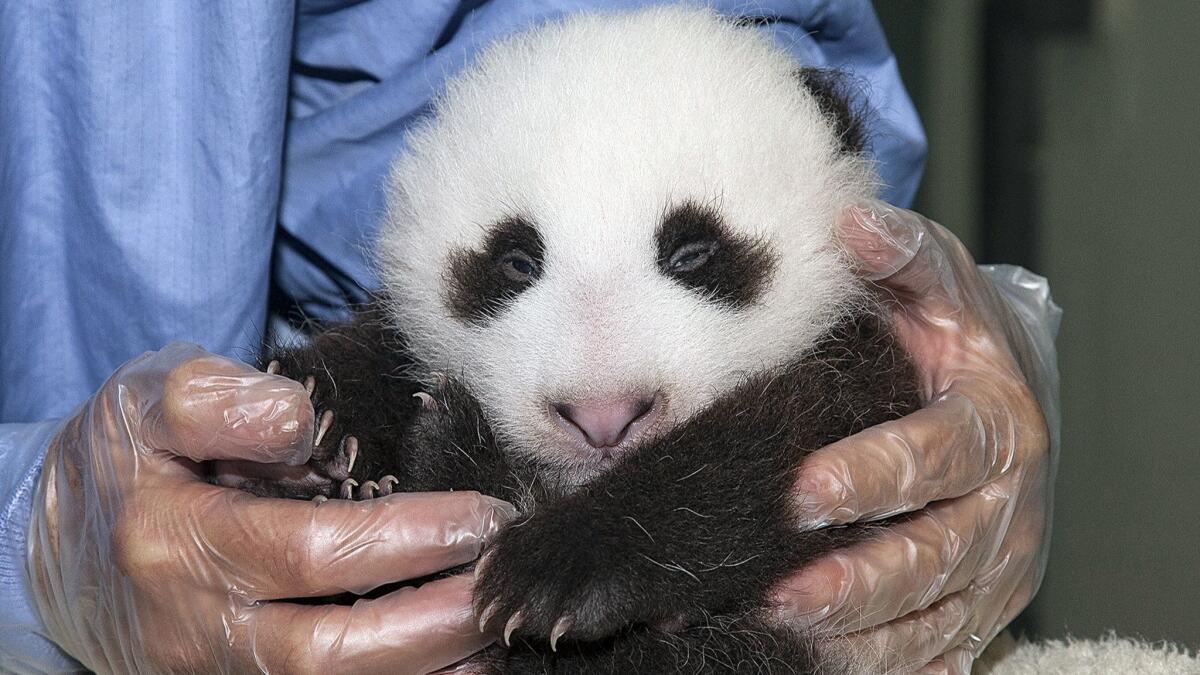
“Panda cubs are so small and so undeveloped that the mother actually has to hold them to her chest,” Durrant said. “They’re just not really designed to hold two cubs, because they actually have to hold them in their arms, like a woman would hold a baby.”
Keepers tried to rescue neglected cubs, feeding and keeping them warm, but they all died.
Chinese keepers in the Wolong breeding center devised a method to save both cubs, called twin swapping. They would use the trust bond with the mother to stealthily take away the neglected cub, and care for it a while, feed it, and then swap again when the mother wasn’t looking.
San Diego Zoo staff assisted in the program, with a little help from Bai Yun’s milk.
“Our nutritionist was able to do a complete analysis on that milk and helped to improve the formula that was being fed to the baby pandas,” Durrant said. “Also, Janet Hawes in our nursery, helped design and develop a nipple that was acceptable and efficient for giant panda cubs.”
“So now when we do the twin swapping, nearly 100% of the second twins survive,” Durrant said. “That just caused this huge population explosion in the breeding facilities in China. In fact, they had to build additional facilities to accommodate all the animals. And a big part of relisting the giant panda from endangered to vulnerable is because of the tremendous captive breeding success.”
What’s next?
Introducing this captive-bred population to the wild requires a “soft release,” Durrant said.
It must be done in stages, habituating them to wild conditions, helping them learn how to find bamboo and feed themselves. Then once they have learned these survival skills, they can be placed back into native habitat.
Pandas that will be potentially released into the wild are born in very large naturalistic enclosures, and have minimal to no human contact prior to release.”
“The reintroduction program is certainly a work in progress, but has had reasonable good success to date,” Owen said.
There are other benefits.
Knowledge gained with pandas can be applied to other rare animals, said Owen, who came to the San Diego Zoo for the panda program. Specifically, lessons learned have helped the zoo’s polar bear program.
“I was a wildlife biologist working in the Arctic,” Owen said. “I did not know the role that zoos could play in wildlife conservation, from the science to the outreach capacity.
“Working on the giant panda program taught me that there should be no barrier between what we can do here at a zoological facility, versus the kinds of science we want to do in the wild.”
Fikes writes for the San Diego Union-Tribune.

